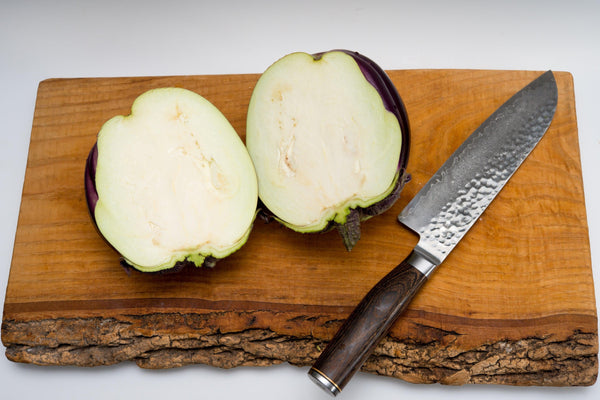
Jump to:
What Is a Santoku Knife?

The santoku knife is a modern Japanese kitchen knife that was created in the 1940s to be a versatile tool for home use. Santoku knives combine the best qualities of Japanese and western knives. Their shape is inspired by traditional nakiri, usuba and deba knives, but they’re sharpened in the same way as a gyuto chef’s knife. The result is a durable multi-purpose knife you can use in the same way you would use a traditional Japanese knife.
Santoku are relatively short, they’re almost never longer than 7 inches. Their blades are quite large, similar to nakiri and deba, not narrow like western knives. The blade’s cutting edge is straight, with a slight curve, but its top edge sharply bends down to meet the bottom. This style is called a “sheep’s foot blade”.
The santoku knife is a multi-purpose knife many Japanese chefs rely on as their primary knife in the kitchen. It can cut meat, seafood, fruit and vegetables, it can slice, dice, mince and chop. Because santoku blades are thinner and shorter than most western knife blades they are extra-light and you can avoid hand-fatigue.
Santoku knives can be found in most homes and restaurants in Japan. They were only invented eighty years ago, but they’ve surpassed traditional Japanese knives in terms of popularity. They’re recommended by Japanese chefs and knife makers as the first good knife you should buy, because they combine the sharpness of Japanese steel blades with the versatility of a western knife.
The History of the Santoku Knife

Japanese kitchen knives have gone through many changes during their 1,300 year history.
The first Japanese knives looked like samurai swords. They had long blades and long handles. This knife style persisted for 1,000 years until the Edo period, when Japan unified under one government and their culture flourished.
In the Edo period, knives that we now call “traditional” Japanese knives were developed and perfected. These knives were ideal for Japanese cuisine. Traditional knives are single-bevel (sharpened on one side of the blade), which makes them sharp and thin. They’re perfect for cutting through vegetables and seafood. You can learn more about them in our article all about the different Japanese knives.
Japan opened up to the west after the Edo period, and Japanese people quickly became interested in western fashion, culture, and food. Most Japanese people at the time ate fruit, vegetables and seafood, but rarely ate other meats. When beef was introduced to the Japanese diet, their appetite for it grew.
When chefs started cooking beef, pork and other tough meats, they realized that traditional Japanese knives weren’t up to the task. The tough muscle and sinew of meat can chip or bend a thin blade. Japanese chefs needed thicker, stronger blades suitable for cutting meat.
Around this time, Japanese blacksmiths created the gyuto knife based on European chef knives. Gyuto can easily cut through meat, but they’re designed for a western cutting technique.
In the early 1940s, because of the growing demand for a versatile and durable knife that you could use like a Japanese knife, the santoku entered the scene. In the 80 years since its invention, it has become the most popular knife in Japan.
What Is a Santoku Knife Used For?

The santoku knife is a versatile kitchen tool, you can use it for a lot of things. In the past, most Japanese knives were single purpose. You’d use a nakiri for vegetables, and a deba for fish. The santoku knife removed the need for so many knives.
Its versatility is represented in its name. “Santoku” means “three virtues” in Japanese. Nobody is certain what the three virtues represent. One idea is that it’s how you use a santoku knife: dicing, slicing, and mincing. Another idea is that it shows what you can cut: vegetables, fish, and meat.
A santoku knife can handle most jobs. However, they can struggle with scoring and detailed cutting. Santoku have sheepsfoot blades, so they don’t have the pointy tip of most western knives. Home chefs don’t have to deal with this problem often, as it’s usually for decorative cutting, but it’s good to know.
There are some benefits to the sheepsfoot blade style. They are easier to control, and you can make total contact with the cutting board. Finishing the cut with total contact on the board makes santoku ideal for hard vegetables like potatoes, carrots and daikon. Even when the skin is on, they make clean cuts right through.
The santoku knife is perfect for clean and uniform cuts. Whether you’re cutting meat, fish, or vegetables, they’re easy to use and maneuverable. Their short blades make them effective in tight spaces, and their versatility means you can slice, dice, chop, mince and more.
How Do I Use a Santoku Knife?

The santoku knife is best suited for Japanese cutting techniques. As they have flat blades, you can’t rock chop, or use a guillotine cutting technique like with a western chef’s knife.
Japanese chefs use an up and down cutting technique with santoku knives. Imagine you’re cutting a daikon radish. Hold the santoku knife in your dominant hand and stabilize the radish in your other hand. Hold your knife straight, and press it against the daikon. Push down, and slightly forward, until your santoku knife makes total contact with the chopping board.
This chopping technique reduces the risk of food slipping while you cut, because you’re making straight, measured cuts and you’re in control of the food and the knife. The risk of accidentally cutting yourself is decreased. They’re safe and easy, even for beginners.
By cutting up and down, and only sliding forward a little, santoku knives require less space than chef knives. You can cut even in cramped kitchens, on narrow chopping boards. The space required to use a santoku knife is essentially equal to the size of the knife, or the item you’re cutting.
The up and down cutting technique means your blade only touches the board at the end of the cut. When you rock chop, the knife is always in contact with the board, which dulls the blade.
How Do I Care for a Santoku Knife?

A kitchen knife is a consumable tool. Each time you use it, it gets less sharp. Each time you sharpen it, it removes some steel. You can prolong the lifespan of your kitchen knives if you take care of them. It’s not uncommon for a santoku knife to last an entire lifetime, if properly cared for.
Wash your knife immediately after using it. Carbon steel is especially prone to rusting. Many ingredients we cook with have salts and acids in them, which speed up corrosion. To protect your knife and prevent food cross-contamination, make a habit of washing your knife after cutting each different ingredient.
Never wash your santoku knife in a dishwasher. If you do, you probably won’t dry it immediately. When knives stay wet, they rust. Carbon steel rusts in as little as five minutes after getting wet. And it’s much easier for your santoku to get chipped in a dishwasher. The water flow can push it into other dishes. To be safe, wash your knife with detergent and a sponge, and dry it right away.
Your santoku knife probably won’t rust if you keep it dry and store it in a place with good ventilation. If you live in a humid area, or are extra worried about corrosion, you can prevent rust by applying a thin layer of cooking oil to the surface of the blade after drying. Wash the oil off before you use it next. If you won’t use your santoku for a while, and want to store it well, Japanese blacksmiths recommend wrapping the blade in newspaper and storing it in a dry place.
If your blade rusts, don’t worry. That happens sometimes. Surface rust won’t damage your knife if you deal with it before it gets out of control. Most of the time, you can remove surface rust with a dry melamine sponge. If that doesn’t work, try a knife-safe commercial rust remover.
If your santoku knife has severe rust, chipping, or rust on the cutting edge of the blade, the best option is to use a whetstone. You can hire a professional knife sharpener to do it for you if you like, but if you own high-quality Japanese knives, learning how to take care of them with Japanese whetstones is part of the journey.
You can remove most minor rust with a 1000 grit whetstone before sharpening on a 6000 grit stone. For very damaged blades, start with something around the 200-300 grit range. We carry the best Japanese whetstone brands in a range of grit sizes, so make sure to take a look.


0 comments